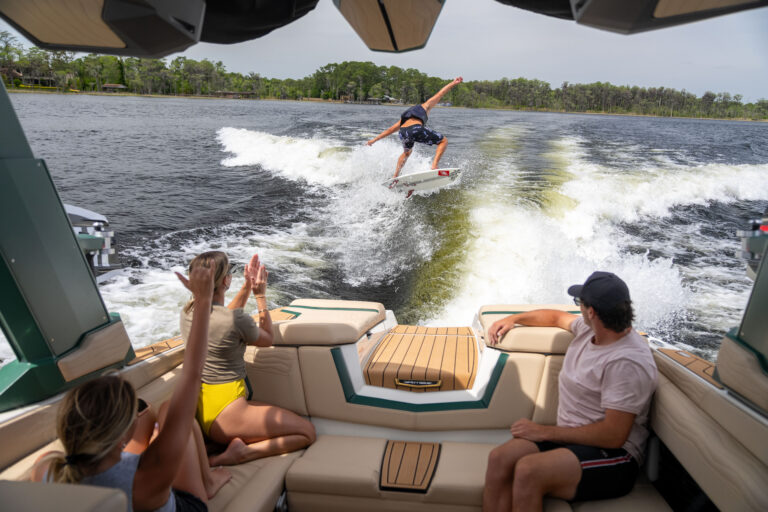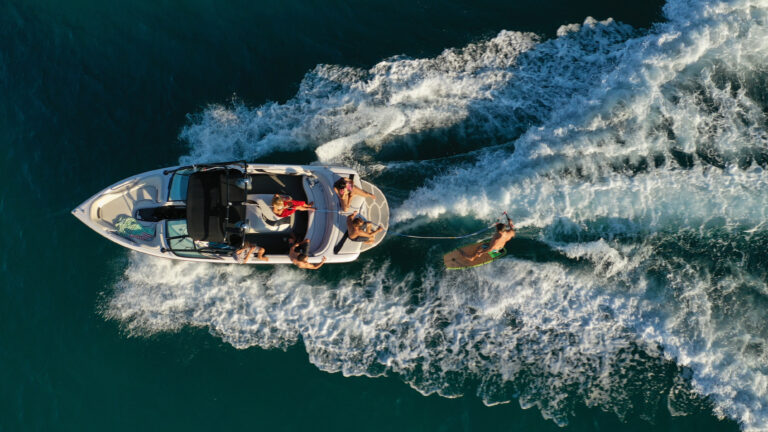The woman in stiletto heels entered the dealership the same way she’d enter a gala dinner. She made her way across the floor, taking strides that made it seem as if she were gliding, like a fashion model on a catwalk. And then, one precisely placed high-heel shoe at a time, she stepped aboard the boat.
In the past, boat designers doing research at the dealership likely would have been men. You know what they would have been thinking. You’re probably thinking it right now. But instead, on this day, the designers taking notes were Sea Ray senior design manager Carrie Fodor and Brunswick Boat Group senior industrial designer Kristin McGinnis, who comprise Sea Ray’s first all-women design team, doing research for the new SLX 260.
Seeing a woman board a boat in stilettos was a first for them, too, but they didn’t give a minute’s thought to it. Instead, they focused on the way people who might buy a premium Sea Ray product behave — key market research they could translate into their design work.

“This was totally normal for them,” McGinnis says. “Just being able to look at boating through that sort of lens of no compromises — you’re not dressing down to rough it going boating. You’re extending your lifestyle onto the water. A lot of these people have really nice waterfront homes. They drive Porches and Land Rovers and Aston Martins.”
The moment was one of many that went into the research Fodor and McGinnis did before designing the SLX 260 as a commonsense extension of that lifestyle. “It might be their premium vehicle to get to a waterfront restaurant,” Fodor says. “We’ve had business owners who raffle off an evening cruise on their boat for a charity event. Things like that. You’re not going to have kids mashing Doritos into the cushions.”
Diversity is Strength
The fact that Sea Ray had an all-female design team for a boat of any style or size was a long time in the making.
For years, the brand, and its parent company, Brunswick Corp., have leaned hard into a diversity initiative. It has included hiring practices that created a staff so diverse that when it’s time to decide who will lead a project, the answer might just as easily be two women as two men.
“You don’t want to be just checking a box,” Fodor says. “You want it baked into your culture so there’s more than just a token female or a token minority. Building diverse teams will give you the greatest perspective and give you the greatest chance at being successful.”

That’s especially true when it comes to design, Fodor and McGinnis say, because truly good design works for everyone, and you’ll never know what everyone thinks unless they’re represented in the room. Simply getting them all in the room takes work. Many young women don’t realize that careers like boat design exist.
“I’d been under the impression that design was something that engineers did,” McGinnis says, adding that after reading an article about a female designer at automaker Acura, she realized there might be a space for her in the field. “I can’t understate the impact that reading that article had on the trajectory of my life.”
Fodor says a panel of female leaders from Brunswick recently spoke to Chicago-area Girl Scout troops, hoping to have a similar impact. “These were middle-school girls learning about what we do. It was great,” Fodor says. “We’d ask whose favorite class was art, or whose favorite class was math, and who in the group likes both, because here’s what you can do with that.”
To Fodor and McGinnis, the design process for the SLX 260 was no different with women leading it. Instead, it was different because they’d known each other for a while. Their interactions were laidback and easygoing, rather than feeling like a pressure-cooker where women were suddenly in the spotlight. “It just happens that Carrie’s and my skill sets really complement each other,” McGinnis says. “Carrie is very much a big-picture visionary — what are the overarching possibilities? How can we really push this idea, whether it’s a boat or anything else? My inclination is to get down into the nuts and bolts of how to get things to work. It really comes back to putting the right people on the project to get the job done.”

The SLX 260
They team had been handed what they describe as a difficult task. It included designing the first Sport model that incorporates new Sea Ray design language — and the first to come out of the company’s newly formed tech center — in about six to eight months.
“When you consider that cars can take five or 10 years to develop, it was the blink of an eye,” McGinnis says. “And with cars, you have so many people on the program. In the marine world, it’s very few people on the project, so you’re responsible for a lot from stem to stern. We model every square inch of the boat. It’s a lot of responsibility and moving parts in a compressed timeline.”
The SLX 260 and SLX 260 Outboard set the stage for how Sea Ray’s new design language will be used going forward on the entire SLX line. Fodor and McGinnis applied the long, sweeping S sheer, the horizontal strake and the Sea Ray emblem centered at the bottom of a “crease” line on the hull. There’s also what they call the “jawline” forward, toward the visible bottom part of the hull, which provides visual lift and makes the boat appear athletic.
“We had to look at applying that to the SLX, which is our premium Sport boat,” Fodor says. “It has the S-sheer with a Sport boat adaptation. It has the horizontal hull crease — it actually has two of them — and then we came up with a new way to sculpt in that jawline. If you look at the 370 Sundancer, that was the first boat with this new design language. On the 260, we’ve sculpted that in and elongated it so that it’s a sculptural version.”
They also did ergonomics studies that included men who are taller than 6 feet and women who are shorter than 5 feet. “We have real, live people for this,” Fodor says. “We take our team members who are different sizes into the mockups and ask if they can reach everything. Are they hitting their head? Are they comfortable? It’s something that we’ve tried to always make happen, but we definitely are increasing the importance of that.”
One result of that exercise was lengthening the 18-inch seat base to 20 inches. “We found that extending that seat-base depth on this boat would be more comfortable for everyone,” McGinnis says. “You have more support under your thighs and knees. We didn’t want the 5-11 female to feel like she was in a La-Z-Boy chair, but it feels a little more plush, like a sofa.”
They also elongated the sun pad and distributed shade differently throughout the boat. “You can be laying in the cockpit or on the sun pad or in the bow. Traditionally, only the cockpit is covered with shade, but we have a lot of concepts for ways to move shade around,” McGinnis says. “This is about having an eye for those little details, the experience, that really makes a huge difference.”
The result, which includes input from Sea Ray’s male and female engineers, is a stylish, smooth-running boat that handles well, McGinnis says. “It grips like a sports car. My boyfriend is a naval architect who worked on the old SLXs. This one handles phenomenally. It’s a blast to drive.”
Going forward, Fodor and McGinnis say, the industry can expect more of the same from Sea Ray — in terms of design within the SLX line and of diverse viewpoints being part of the process to create better products. They say anyone running a company that wants to build a similarly diverse team should focus on the skills and perspectives that team members bring to the table, without making assumptions about what those skills and perspectives might be.
“When you can help people feel that they belong — that they are accepted as part of the team without assumptions — it creates culture,” Fodor says. “That’s how cultures change. When you can create belonging at work, you can exponentially increase the success of the company.”
McGinnis says marine executives who don’t know where to start should think about creating a culture that would feel comfortable to them at a marina. “If you’re backing a boat into a dock,” she says, “there’s a big difference between people judging you from the dock or people ready to throw you a line because they know you’re going to do just fine.”
This article was originally published in the July 2022 issue.











